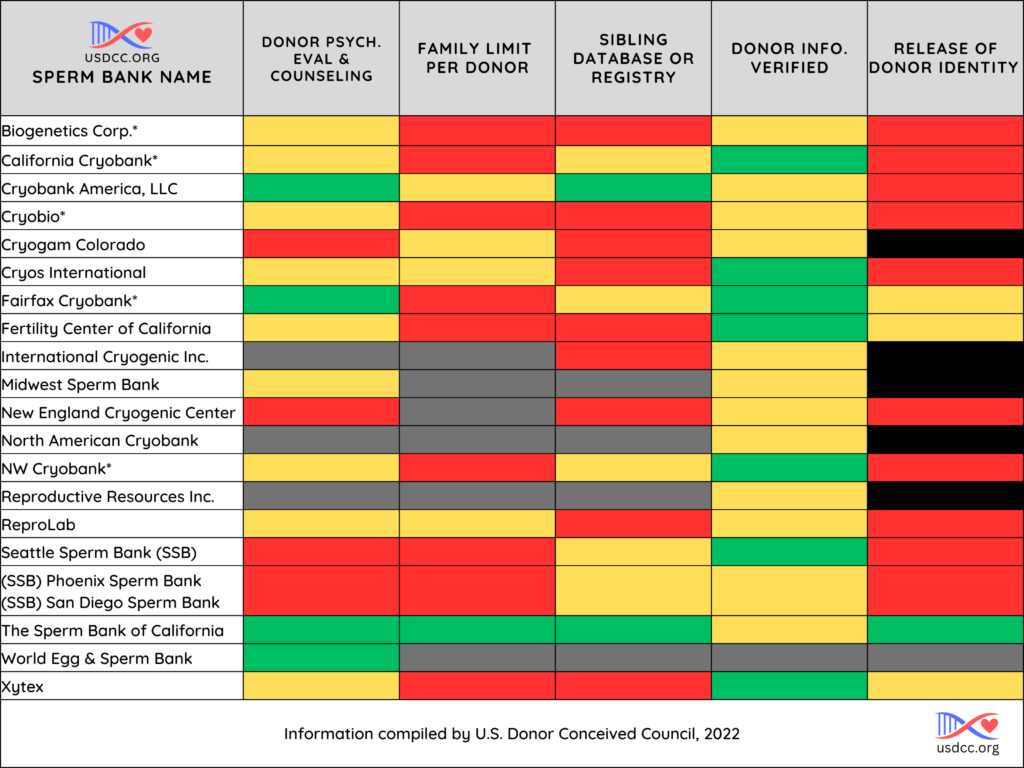
The goal of USDCC’s traffic light chart is to provide a visual assessment of U.S. sperm bank policies and practices in five areas of comparison selected to correspond with responses to USDCC’s 2022 Advocacy Survey. Each sperm bank’s policies and practices are described in depth within USDCC’s 2022 Sperm Bank Survey (PDF). For an explanation of the traffic light chart’s categories and colors, see below.

*Denotes that this bank’s information is the same for subsidiary/satellite locations.
- Biogenetics Corp.: Same for The Sperm & Embryo Bank of New York, Inc.
- California Cryobank: Same for locations in Cambridge, MA; Manhattan, NY
- Cryobio: Same for Pittsburgh Cryobank
- Fairfax Cryobank: Same for locations in Pasadena, CA; Minneapolis, MN; Philadelphia, PA; Houston, TX; Austin, TX; Miami, FL
- NW Cryobank: Same for location in Missoula, MT
CHART EXPLANATION
1. Donor Psychological Evaluation & Counseling
- Green: Sperm bank conducts a psych eval AND provides counseling on the consequences of donation to each sperm donor.
- Yellow: Sperm bank conducts a psych eval of each sperm donor but does not require counseling.
- Red: Sperm bank does not conduct a psych eval of donors.
- Grey: Unknown
2. Family Limits
Some sperm banks use an international limit, some use a domestic limit, and some limit families per state, based on population, or per “region.” Some sperm banks list international limits that are lower than their domestic limit, while a bank’s so-called “global limit” is presumably the sum of the two numbers. Actual adherence to a family limit is also dependent upon live birth reporting.
A comprehensive assessment of sperm bank family-limit information is difficult, if not impossible, to accurately condense into an at-a-glance chart, but more detailed information is available in the long-form version of USDCC’s 2022 Sperm Bank Survey (PDF).
- Green: Global family limit of less than or equal to 10.
- Yellow: Global family limit of 11-25.
- Red: Global family limit greater than 25.
- Grey: Unknown
3. Operation of a Sibling Database or Registry
Most sperm banks with sibling databases or registries indicated a donor conceived person (DCP) must provide evidence of their conception with sperm from the particular bank, which means DCP whose parents did not report a live birth and/or did not keep records from the bank would presumably have trouble accessing any available database or registry. Most banks did not indicate requiring live-birth reports from parents.
- Green: Provides a sibling database or registry. Attempts to require live-birth reports.
- Yellow: Provides a sibling database or registry. Does not require parents live-birth reports.
- Red: Does not provide a sibling database or registry.
- Grey: Unknown
4. Verification of Donor Information
Sperm banks were asked if and how they fact check the personal and family medical history provided by donors, as well as whether they conduct expanded genetic carrier screening, some level of criminal history check of donors, and verify the educational background of prospective donors.
- Green: Conducts expanded genetic carrier screening, some level of criminal history check, requires a diploma or transcript from prospective sperm donors as evidence of educational background.
- Yellow: Conducts some, but not all, listed screenings.
- Red: Does not conduct any listed donor screening.
- Grey: Unknown
5. Donor Identity is Subject to Release
The majority of sperm banks continue to offer anonymous sperm donors, though some are beginning to only accept sperm donors whose identities will be subject to release when the donor conceived person turns 18 and requests the information.
- Green: All donors subject to release of identity.
- Yellow: No longer accepts but still offers anonymous donors with open identification donors.
- Red: Accepts and offers anonymous sperm donors with open identification donors.
- Black: Only offers anonymous donors.
- Grey: Unknown
A bank’s inclusion on this page does not signify endorsement by USDCC, nor should inclusion be understood as an endorsement of the quality of a bank’s stated practices and policies or a guarantee that a bank actually adheres to those stated practices and policies.
The information on this page has been checked against each bank’s publicly available data online and has, to the best of USDCC’s ability, been verified by personal contact with the bank via email or phone call in 2022. Not all banks responded or fully responded to USDCC’s verification efforts. If you believe USDCC has received erroneous information about a bank’s policies or practices or would like to provide verification of your bank’s data for our next survey, please reach out to [email protected].
Top Image by Juan Sisinni via Unsplash
